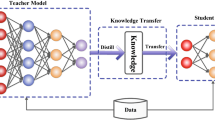Abstract
As the deep learning technology grows, the accuracy of the training data to improve the model becomes important. If there are not enough learning data between classes, there is a problem that the accuracy of the deep learning model is greatly reduced. In this paper, we propose a method to solve data imbalance caused by the difficulty of collecting learning data through DA-FSL(Data Augmentation based Few-Shot Learning). The proposed method is to separate the class with the data imbalance and the normal class, and to re-learn by creating the data of the data imbalance class through DA-FSL. It adopts GAN(Generative Adversarial Network) architecture, then initialize through mapping network to improve the generation accuracy and speed of new latent vector. The purpose of this paper is to verify whether the data imbalance of gender classification model can be solved through the experiments applied by the proposed method and to prove its effectiveness.
















Similar content being viewed by others
References
Animal Species Image Recognition for Restricting Access Dataset, https://www.kaggle.com/c/dogs-vs-cats, [Accessed : Sep. 10. 2020]
Bochkovskiy A, Wang CY, Liao HYM (2020) YOLOv4: Optimal Speed and Accuracy of Object Detection. arXiv preprint. arXiv:2004.10934
CS231n Convolutional Neural Networks for Visual Recognition, https://c231n.github.io/transfer-learning/, [Accessed : Sep. 13. 2020]
Estabrooks A, Jo T, Japkowicz N (2004) A Multiple Resampling Method for Learning from Imbalanced Data Sets. Int J Comput Intell 20(1):18–36. https://doi.org/10.1111/j.0824-7935.2004.t01-1-00228.x
Fan W, Watanabe T, Asukura K (2010) Mining underlying correlated-clusters in high-dimensional data streams. International Journal of Social and Humanistic Computing 1(3):282–299. https://doi.org/10.1504/IJSHC.2010.032689
Girshick R, Donahue J, Darrell T, Malik J (2014) Rich feature hierarchies for accurate object detection and semantic segmentation. 2014 IEEE Conference on Computer Vision and Pattern Recognition. https://doi.org/10.1109/CVPR.2014.81
Girshick R (2015) Fast R-CNN. The IEEE International Conference on Computer Vision 1:1440–1448. https://doi.org/10.1109/ICCV.2015.169
Goodfellow I, Pouget-Abadie J, Mirza M (2014) Generative Adversarial nets. Neural Inf Proces Syst 2:2672–2680
Ioffe S, Szegedy C (2015) Batch normalization: Accelerating deep network training by reducing internal covariate shift. arXiv preprint arXiv:1502.03167
Japkowicz N, Stephen S (2002) The class imbalance problem: A systematic study. Intelligent Data Analysis 6(5):429–449. https://doi.org/10.3233/IDA-2002-6504
Jiang L, Zhou Z, Leung T et al (2018) MentorNet: Learning Data-Driven Curriculum for Very Deep Neural Networks on Corrupted Labels. International Conference on Machine Learning
Kerras T, Laine S, Aila T (2019) A style-based generator architecture for generative adversarial networks. In Proceedings of the IEEE Conference on Computer Vision and Pattern Recognition: 4401–4410
Koch G, Zemel R, Salakhutdinov R (2015) Siamese neural networks for one-shot image recognition. ICML deep learning workshop 2(1)
Li D, Zhang J, Yang Y, Liu C, Song YZ, Hospedales T (2019) Episodic training for domain generalization. Proceedings of the IEEE International Conference on Computer Vision: 1446–1455
Liu S, Qi L, Qin H, Shi J, Jia J (2018) Path aggregation network for instance segmentation. In Proceedings of the IEEE Conference on Computer Vision and Pattern Recognition: 8759–8768
Liu L, Ouyang W, Wang X, Fieguth P, Chen J, Liu X, Pietikainen M (2019) Deep Learning for Generic Object Detection. Int J Comput Vision 1:1–58. https://doi.org/10.1007/s11263-019-01247-4
Pan SJ, Yang Q (2009) A survey on transfer learning. IEEE Transaction on knowledge and data engineering 22(10):1345–1359
Purkait P, Zhao C, Zach C (2017) SPP-Net: Deep absolute pose regression with synthetic views. arXiv preprint. arXiv:1712.03452
Redmon J, Divvala S, Girshick R, Farhadi A (2016) You only look once: Unified, real-time object detection. Proc IEEE Conf Comput Vis Pattern Recognit 1:779–788. https://doi.org/10.1109/CVPR.2016.91
Ren S, He K, Girshick R, Sun J (2017) Faster R-CNN: Towards Real-Time Object Detection with Region Proposal networks. IEEE Transaction on Pattern Analysis and Machine Intelligence 39(6):1137–1149. https://doi.org/10.1109/TPAMI.2016.2577031
Rodrigues A, Pinheiro PR, Rodrigues MM et al (2010) Applying a multicriteria model for selection of test use cases: a use of experience. International Journal Social and Humanistic Computing 1:246–260. https://doi.org/10.1504/IJSHC.2010.032686
Redmon J, Farhadi A (2017) YOLO9000: better, faster, stronger. In Proceedings of the IEEE conference on computer vision and pattern recognition: 7263–7271
Redmon J, Farhadi A (2018) YOLOv3 An Incremental Improvement. arXiv preprint. arXiv:1804.02767
Snell J, Swersky K, Zemel R (2017) Prototypical networks for few-shot learning. In Advances in neural information processing systems: 4077–4087
The Pascal VOC (2012) http://host.robots.ox.ac.uk/pascal/VOC/voc2012/, [Accessed: Nov. 8. 2019]
UMD Faces Dataset http://umdfaces.io/, [Accessed: Nov. 7. 2019]
Vinyals O, Blundell C, Lillicrap T, Wiestra D (2016) Matching networks for one shot learning. In advances in neural information processing systems 3630–3638
Wang CY, Liao HYM, Yeh IH, Wu YH, Chen PY, Hsieh JW (2019) Cspnet : A new backbone that can enhance learning capability of cnn. arXiv preprint. arXiv:1911.11929
Wong SC, Gatt A, Stamatescu V, McDonnell MD (2016) Understanding Data Augmentation for Classfication When to Warp?. IEEE International Conference on Digital Image Computing: Techniques and Applications. https://doi.org/10.1109/DICTA.2016.7797091
Zhexue H (1998) Extensions to the k-means algorithm for clustering large data sets with categorical values. Data Min Knowl Disc 2(3):283–304. https://doi.org/10.1023/A:1009769707641
Funding
This work was supported by the National Research Foundation of Korea (NRF) Grant funded by the Korean Government (NO. 2017R1D1A1B04030870).
Author information
Authors and Affiliations
Corresponding author
Additional information
Publisher's Note
Springer Nature remains neutral with regard to jurisdictional claims in published maps and institutional affiliations.
Rights and permissions
About this article
Cite this article
Lee, JM., Kang, Ds. Improved method for learning data imbalance in gender classification model using DA-FSL. Multimed Tools Appl 80, 34403–34421 (2021). https://doi.org/10.1007/s11042-021-11309-w
Received:
Revised:
Accepted:
Published:
Issue Date:
DOI: https://doi.org/10.1007/s11042-021-11309-w




